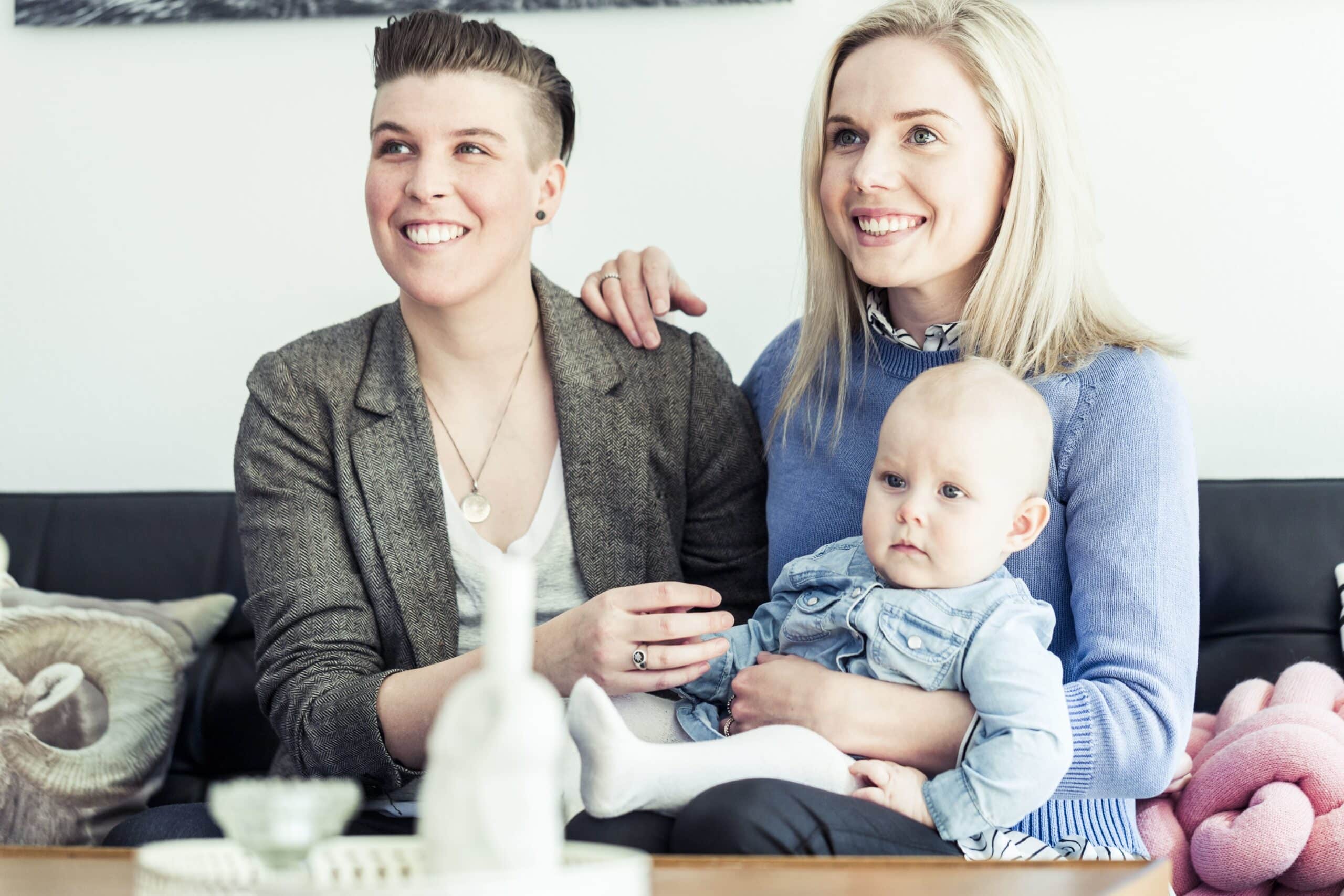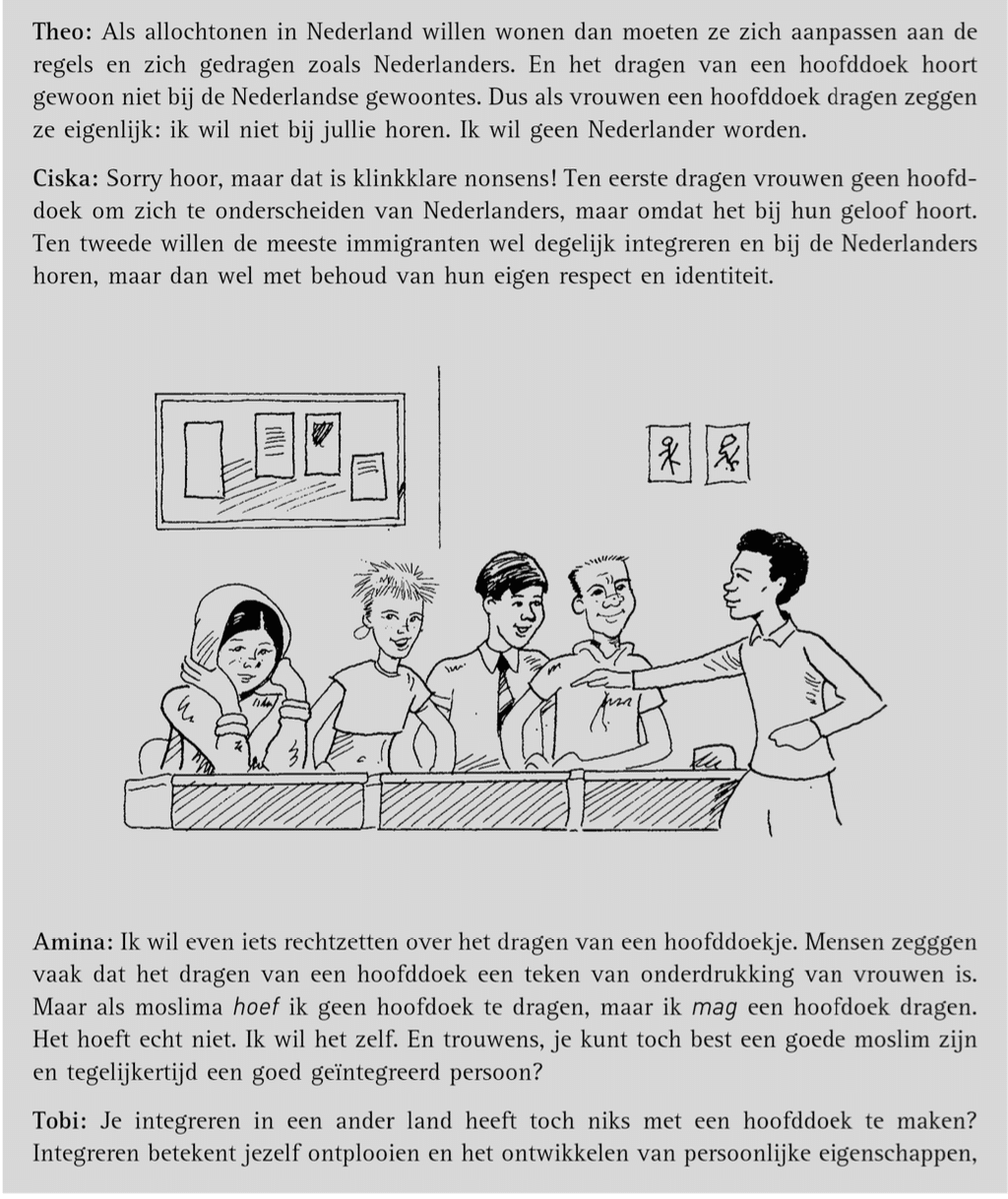Sam Plays Sports, Saskia Shops: Gender and Other Stereotypes in Textbooks for Newcomers
Teaching material should exhibit diversity, according to policy organisations such as UNESCO. That includes textbooks for newcomers to Flanders and the Netherlands. What image of Dutch-speaking cultures do these textbooks convey? Have they evolved with social developments when it comes to gender and ethnic diversity? Dietha Koster (University of Münster) shares her latest research findings.
Although more and more digital reading materials are reaching the classroom, the textbook remains prevalent among learning materials, including those for newcomers to Flanders and the Netherlands. The books for the latter group, with information about Dutch-speaking cultures, have been in production since the 1970s. For newcomers, that textbook material is often their first acquaintance with these societies. The books generally contain many texts about and images of women and men in specific roles.
Social gender roles in the Netherlands and Flanders have changed over the years. (By gender
we mean the behaviours by which we sort people into woman, man or otherwise.) For instance according to Statistics Netherlands (CBS) Dutch women go to work more, also working in what were once exclusively male occupations. Men work a little less and sometimes take on more domestic tasks and activities in the family. Women and men of ethnic minorities and people of non-binary identities and sexualities have become more visible in social debates. To what extent have representations of people in textbooks evolved to reflect these developments?
From typist to engineer?
Often a primary goal of education for new arrivals is to groom them for the labour market in the Netherlands and Flanders. Almost every textbook for newcomers therefore contains a chapter or section about work and careers. From a diversity perspective it is desirable that the learning material should present newcomers of different gender identities with varied career options. Textbooks that do justice to diversity increase the chance that students will recognise themselves, enabling them to participate better in the class. UNESCO, for instance, suggests mentioning a female occupational title alongside each male title.
Women in textbooks for new arrivals are less prominent as professionals than men
From our research it appears, however, that women in textbooks for new arrivals are less prominent as professionals than men. Female titles (such as typiste, the Dutch for a female typist) appear half as often in texts as male titles (politieman, policeman). That applies both to older textbooks (1974-2009) and to more recent material (2010-2017). Women are also less prominent due to gender neutral titles more often referring to men. This can be seen, for instance, in sentences such as: De wethouder werkt in zijn kantoor. Hij heeft het druk. (‘The alderman works in his office. He is busy.’)
Men are also far more often mentioned first in sentences, as in Harry en Anna werken, rather than Anna en Harry werken (‘Harry and Anna work’ vs ‘Anna and Harry work’). Women are further described in stereotypically female, low-status occupations. New arrivals see plenty of secretaries, female nurses and salespeople, but few or no women as directors, presidents or engineers. They also see no women in jobs traditionally done by men, such as builders or road workers. Men are also described in jobs with little status, but in less stereotypical male occupational groups, such as driver or hairdresser.
From a diversity perspective these findings leave something to be desired. Over time there has also been little discernible evolution. In order to fulfil the diversity guidelines, working women should be more prominent and should be presented in more varied roles.
Women are often associated with being not qualified or competent
Textbooks for newcomers contain dialogues in which students take on roles and read out scripts. Such roleplays force students into a model of reality to some extent. Our research shows that men in general speak a little more than women in dialogues. We investigated where themes such as friendship, illness and appearance were discussed, as well as themes such as crime, politics, national identity and (financial) success. Previous research has shown that the former themes largely arise among women, while the latter group are primarily discussed by men. The study shows that women more often talk about female rather than male themes, whereas men are allocated both themes. This applied both to older materials and to more recent textbooks. Women are often associated with being “not qualified or competent”, whereas that is not the case for men. See the following dialogue, titled ‘A little light relief’, in a textbook from 1974:
Interviewer: So to sum up, you can’t type, you don’t know shorthand, you have no bookkeeping experience, and you haven’t the slightest idea about business correspondence. Young lady, why are you applying?
Young lady: For the overtime.
Although such texts do not appear in the most recent books, here too the dialogues are ripe for improvement when it comes to gender diversity. The share of the conversation should be proportionate: women can talk about more varied themes, and if they are associated with incompetence, then the same should go for men.
Mother smiles, father is irritable
Textbooks for new arrivals generally also contain a chapter about family relationships. Here newcomers learn to talk about their own family and those of others. Family configurations can vary from the traditional nuclear family to rainbow families, single parent families and blended families. In our research into this theme we again focused on the roles in which men and women appear, and the sexual identities of the people in the textbooks.
Textbooks appear to have many nuclear families with a heterosexual mother, father and two children. We infer heterosexuality, for instance, from images in which women and men kiss each other, or from family trees with heterosexual marriages. Heterosexuality can also be inferred from scripts, such as the sentences “A few years ago Belgin married a Dutch man” or “Marie: ‘I’m still looking for the ideal man.’” Characters with other sexual identities are not identifiable in the chapters. Only the textbook Welkom in de klas! (2018) explicitly presents a lesbian couple. This couple is standing between photos of two other families, with the instruction: Look at the photo and describe the families. Since 2001 the teacher’s guide has included advice to discuss homosexual marriage in the Netherlands. But in contrast to the heterosexual characters, the lesbian couple do not take on a central position in the chapter or the book.
 The textbook "Welkom in de klas!" (2018) is the only one showing a lesbian couple with a child.
The textbook "Welkom in de klas!" (2018) is the only one showing a lesbian couple with a child.Ⓒ iStock
Men can be seen gripping the shoulders or waists of women, while the reverse is not the case
Photos and drawings of women and men reveal stereotypical activities. Only women are depicted shopping for clothes, hugging or smelling flowers. Exclusive male activities include writing, playing sports or showing off cars. Moreover men can be seen in photos gripping the shoulders or waists of women, while the reverse is not the case. Such images can contribute to stereotypes of passive women and active men. Both women and men directed their gaze in all directions in the images, or in a couple of cases had their eyes closed. In older books it was mainly the men who looked directly into the camera, but in more recently published books women exhibited an equally confident gaze. Fathers are often depicted as distant, both literally and emotionally, by their position (far from the children) and with facial expressions without emotion or as irritable fathers. Mothers, in contrast, are depicted laughing and cuddling babies.
In terms of diversity it would be good to present more different sexual identities in the textbooks and to mention them in more prominent positions. The recommendation not to portray women merely as passive and emotional and men purely as active and rational is also underlined by UNESCO. Including examples of less stereotypical activities and behaviours can help achieve more balance.
Little colour
Not only is gender diversity important but, according to UNESCO, textbooks should also show people of different skin colours as well as white people. New arrivals in Flanders and the Netherlands are often themselves members of black, Asian or minority ethnic (BAME) groups, and can benefit from seeing BAME women and men in diverse roles.
A study of gender and ethnicity in six recently published, popular textbooks for new arrivals shows little colour. Ethnicity refers to the supposed common background of a group of people. Besides factors such as nationality, religion and language, skin colour can contribute to the formation of ethnic groups. Of the 806 characters depicted in the textbooks, 233 (28.9 percent) have non-white skin. These characters appeared in a single textbook, Contact, published in 2019. If Contact
were excluded from the analysis, there would only have been 26 non-white characters out of 605 (4.3 percent) in the textbooks. White men are depicted most often (336), followed by white women (269), non-white men (14) and in the last place non-white women (12).
In the texts by the images of members of ethnic minorities, their ethnicity was generally not mentioned. Where it was discussed, it is noteworthy that the characters are flagged up as “different”, for instance by reference to their non-Dutch or non-Belgian nationality. Moreover for BAME people, their hair and skin colour and non-Western attire is sometimes mentioned or presented as a problem (as in the discussion exercise shown here about headscarves from Routledge Intensive Dutch, 2006), whereas that does not happen for white characters.
Our study also shows that BAME people are described in a limited number of roles: tourist, student, cook, waiter, migrant, poor person, asylum seeker, job seeker or a recipient of development aid. We see few or no BAME pilots, doctors or professors.
 A discussion exercise from the textbook "Routledge Inensive Dutch" (2006)
A discussion exercise from the textbook "Routledge Inensive Dutch" (2006)Ⓒ Routledge
Nationality and language variation
When we focus on nationality, it is striking that the Netherlands, Dutch nationality and Dutch cities (Utrecht, Amsterdam, Houten) are most frequently mentioned in the books. Belgium, Belgian nationality and Belgian cities are seldom mentioned, with the exception of the textbook which we researched from Flanders. Other countries or regions where the Netherlands is the working language (or one of the working languages), such as Suriname, Curaçao, Aruba or Sint Maarten are not mentioned. Indonesia is the only former colony that appears a few times in the texts. In general European nationalities figure more frequently than non-European identities in the textbooks. In terms of nationality, once again with the exception of the textbook Contact (2019), a meagrely diverse, predominantly Dutch- and Eurocentric trend is discernible.
Neither can any diversity be found in the audio tracks, as almost all characters speak Standard Dutch
On this point, too, we investigated the dialogues, which turned out to be largely populated by Sams, Harrys, Jaspers, Saskias, Tinas and Ediths. Neither can any diversity be found in the audio tracks, as almost all characters speak Standard Dutch. Even when it is noted that characters do not come from the Netherlands or Flanders, but for instance from Austria, Germany or Italy, or when they are presented as BAME, they still speak Standard Dutch. Only two women of the 453 characters speak either Flemish Dutch or Dutch with an Italian accent.
A prominent function of characters who are marked out as “different”, seems to be to teach newcomers sentences that place them in a position of dependency. Sentences such as “Could you repeat that?” or “I don’t understand. What do you mean?”
A more diverse collection of dialogues would allow newcomers to hear variants on Standard Dutch. It is also desirable that characters marked out as “different” should carry out diverse linguistic functions, for instance not only questioning but also directing.
Diversity is a verb
Conclusions? Textbooks for newcomers are lagging behind in diversity terms. The gender roles in textbooks are insufficiently evolved, let alone presenting possible future realities with more gender and ethnic diversity. In fact, gender stereotypes are reproduced. Furthermore we see that, with the exception of a single textbook, there are few or no BAME people or people with different sexual identities in textbooks for new arrivals. Moreover it is striking that when those people do appear, they are allocated a limited number of roles and marked out as “different”.
So there is work to be done for researchers, publishers, textbook authors and teachers to adapt textbooks (and other learning materials) to diversity guidelines such as those of UNESCO. Researchers have the task of exposing inequalities and communicating them to producers and users of learning materials. Publishers and authors can examine their new publications in order to break the cycle of stereotype perpetuation. Insofar as they have not already done so, teachers in the Netherlands, Flanders and elsewhere can inform themselves, so that they grow better at recognising diversity (or the lack thereof) in textbooks and teaching materials. They can then raise the subject of diversity in the class, for example by discussing a newspaper article about rainbow families, alongside a textbook chapter with lots of traditional nuclear families. Or they can address new arrivals themselves.
Newcomers themselves may be the most valuable source of diverse lesson themes. Classes of newcomers are composed of people with diverse occupational and family backgrounds, with a range of (double) nationalities, with different migration backgrounds and ethnic and gender identities. Education that in principle starts out from new arrivals, instead of education based on traditional nationalistic and patriarchal structures, is a route to high-quality, diverse teaching materials, with shopping Vladimirs and Sams and sporty Leilas and Saskias.












